Negative space can transform your aerial photography from ordinary to extraordinary. Frame subjects with sky, create minimalist landscapes, and emphasize scale with emptiness. Contrast textures and isolate subjects in vast spaces for visual impact. Use leading lines in open areas to guide the viewer's eye. Explore symmetry and asymmetry from above, and highlight patterns through separation. Don't forget to incorporate negative space in urban aerials for striking compositions. Experiment with different angles and altitudes to maximize the effect. By mastering these techniques, you'll elevate your aerial photography to new heights. The sky's the limit for what you can achieve with these powerful compositional tools.
Key Takeaways
- Frame subjects with sky, using it as natural negative space to enhance focus and create dynamic compositions.
- Isolate subjects in vast spaces like water or sand to create clean, impactful backgrounds and visual interest.
- Create minimalist landscapes by highlighting patterns and textures visible only from aerial perspectives.
- Emphasize scale by contrasting small subjects with expansive emptiness, positioning them near frame edges.
- Use negative space to balance compositions, create leading lines, and enhance urban aerial photography.
Framing Subjects With Sky

When shooting from up in the air, you'll find that the sky becomes a powerful tool for framing your subjects. The vast expanse of blue or cloud-filled sky can act as a natural negative space, drawing attention to your main subject.
To effectively use the sky as a frame, position your subject off-center and allow the sky to dominate the composition. This technique creates a sense of scale and isolation, making your subject stand out dramatically.
Consider the time of day and weather conditions when framing with sky. Early morning or late afternoon light can add warm hues and long shadows, enhancing the contrast between sky and subject. Cloudy skies offer texture and depth, while clear blue skies provide a clean, minimalist backdrop.
Experiment with different altitudes to adjust the sky-to-subject ratio. Flying higher increases the amount of sky in your frame, potentially emphasizing the subject's small size within a vast landscape. Lower altitudes can create a more intimate feel, with less sky visible.
Don't forget to pay attention to the horizon line. Keeping it straight adds professionalism to your shots, while tilting it can create dynamic tension in the composition.
Minimalist Landscapes From Above

Aerial photography offers a unique perspective for capturing minimalist landscapes. From above, you'll find patterns, shapes, and textures that aren't visible from the ground. To create striking minimalist compositions, focus on isolating single elements within vast expanses of negative space.
Look for large, uniform areas like deserts, snowfields, or calm bodies of water. These serve as perfect blank canvases for your subjects. Seek out lone trees, solitary buildings, or singular geological features to serve as focal points. The contrast between these subjects and their surroundings creates powerful visual impact.
Consider the following elements when composing minimalist aerial landscapes:
| Element | Natural | Man-made |
|---|---|---|
| Linear | Rivers | Roads |
| Circular | Lakes | Crop circles |
| Angular | Mountains | Buildings |
| Organic | Sand dunes | Parks |
Pay attention to color contrast as well. A red barn in a snow-covered field or a dark island in a turquoise sea can create stunning minimalist images. Remember, in minimalist aerial photography, less is often more. By embracing negative space, you'll create impactful images that draw viewers in and invite contemplation.
Emphasizing Scale With Emptiness
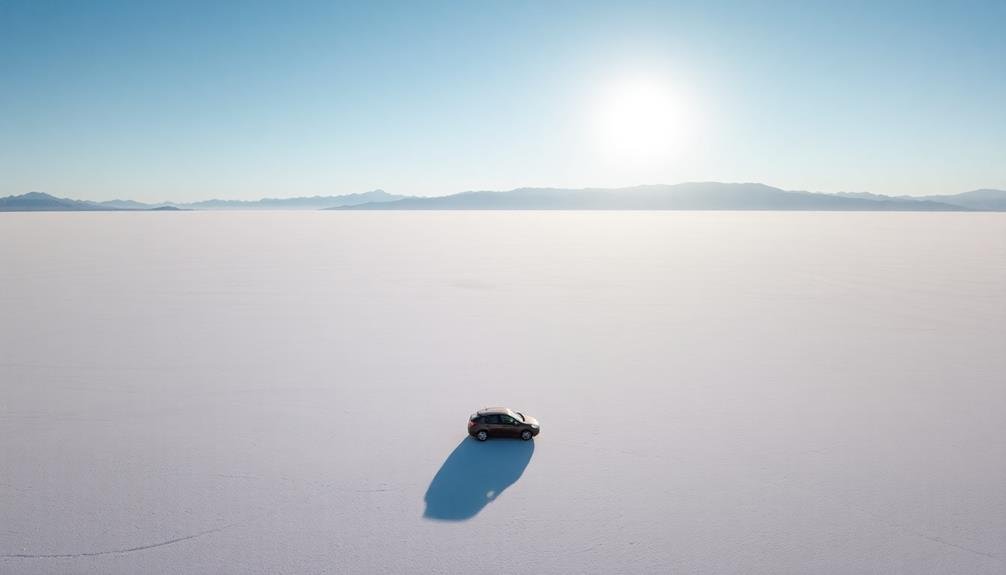
Scale becomes a powerful tool in aerial photography when you leverage negative space effectively. By contrasting small subjects against vast empty areas, you can create a striking sense of scale and isolation.
Look for opportunities to capture lone objects or figures surrounded by expansive landscapes, such as a single boat in a large body of water or a solitary tree in a desert.
To emphasize scale, position your subject near the edge of the frame, allowing the negative space to dominate the composition. This technique draws the viewer's eye to the subject while simultaneously highlighting its relative size within the environment.
You'll find that the greater the contrast between the subject and its surroundings, the more impactful the sense of scale becomes.
Experiment with different altitudes to fine-tune your compositions. Higher elevations often reveal patterns and textures in the landscape that can serve as interesting negative space.
Don't shy away from minimalist compositions; sometimes, a simple horizon line dividing sky and land can create a powerful statement about scale and emptiness.
Contrasting Textures in Aerial Shots

Juxtaposition of textures creates visual intrigue in aerial photography. When you're shooting from above, you can leverage negative space to highlight contrasting textures in your frame. Look for areas where smooth surfaces meet rugged terrain or where organic patterns intersect with man-made structures.
You'll find that water bodies often provide excellent opportunities for texture contrast. A calm lake surrounded by dense forests or a winding river cutting through rocky landscapes can create striking compositions.
Urban environments also offer unique texture juxtapositions, such as sleek skyscrapers rising from textured city blocks or modern highways snaking through older neighborhoods.
To enhance these contrasts, adjust your altitude and angle. Flying higher can simplify textures, while lower altitudes emphasize detail. Experiment with different lighting conditions; harsh midday sun can accentuate texture differences, while softer light might blend them more subtly.
When framing your shot, use negative space strategically to isolate and emphasize textural elements. This technique can draw the viewer's eye to the most interesting contrasts and create a more engaging composition.
Isolating Subjects in Vast Spaces
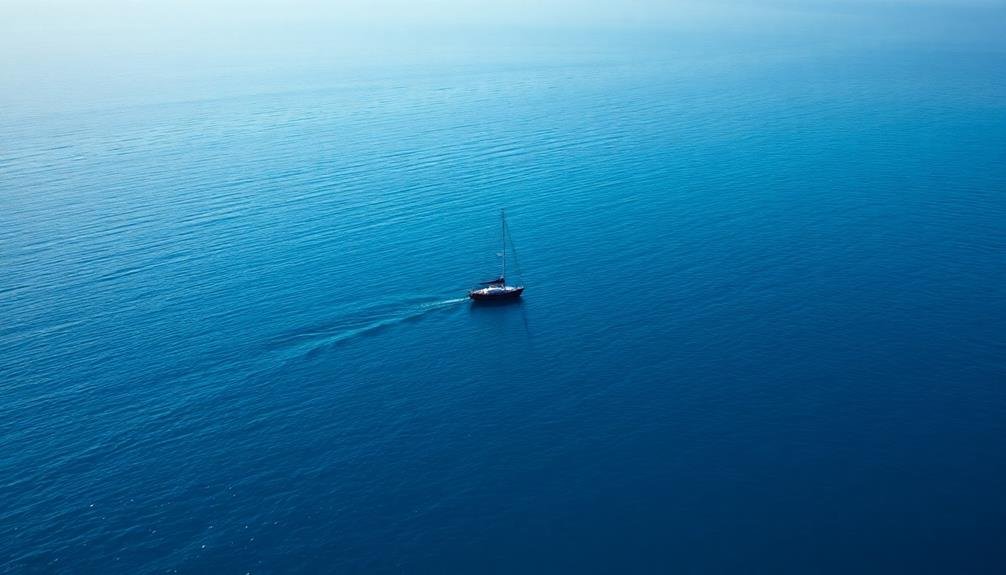
While texture contrasts create visual interest, the ability to isolate subjects within vast expanses is a powerful technique in aerial photography.
When you're shooting from above, you'll often encounter large, open spaces that can overwhelm your subject. By using negative space strategically, you can draw attention to your main subject and create a sense of scale and isolation.
To effectively isolate subjects in vast spaces, consider these tips:
- Use natural elements like water, sand, or snow as a clean backdrop
- Position your subject off-center to create balance and visual interest
- Play with shadows to add depth and dimension to flat surfaces
- Experiment with altitude to find the perfect balance of subject and space
- Look for unique patterns or textures that complement your subject
Creating Balance With Negative Space
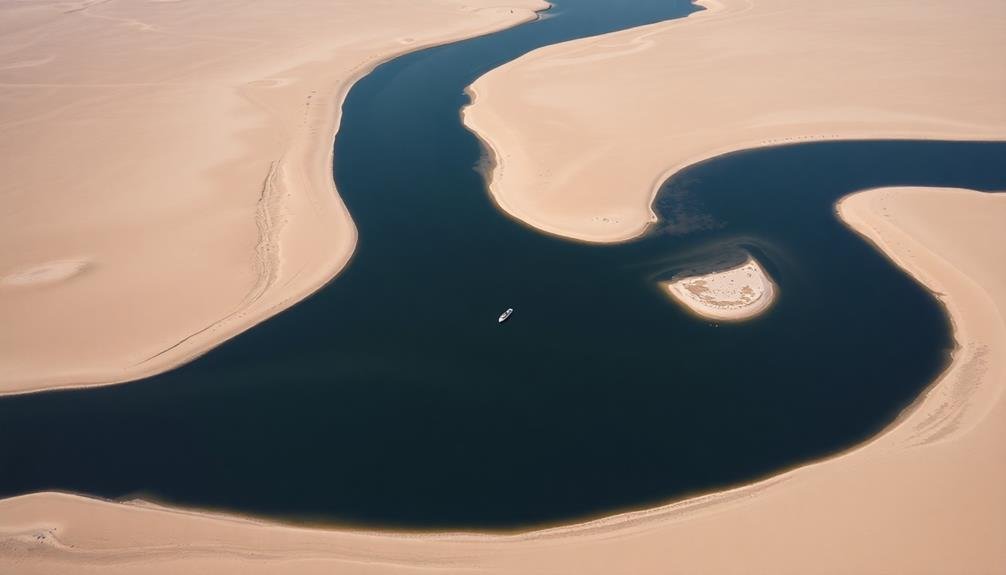
Balance is a fundamental principle in aerial photography, and negative space plays a crucial role in achieving it. When you're composing your aerial shots, use negative space to create equilibrium between your subject and the surrounding environment.
Look for opportunities to position your main subject off-center, allowing the empty areas to counterbalance it visually. You can create dynamic tension by placing your subject near the edge of the frame, with negative space filling the majority of the image. This technique draws the viewer's eye across the photograph, creating a sense of movement and intrigue.
Experiment with different ratios of subject to negative space to find the perfect balance for each shot. Consider the shape and color of your negative space as well. Use contrasting elements to make your subject stand out, or incorporate complementary colors to create a harmonious composition.
Don't be afraid to embrace minimalism; sometimes, a small subject surrounded by vast negative space can create a powerful, emotive image. Remember that negative space isn't just empty filler—it's an active element that can enhance your aerial compositions and tell a compelling visual story.
Leading Lines in Open Areas

Leading lines are a powerful compositional tool in aerial photography, especially when working with open areas and negative space. They guide the viewer's eye through the image, creating depth and interest in what might otherwise be an empty space.
When you're shooting from above, look for natural or man-made features that can serve as leading lines in open landscapes.
Consider these elements as potential leading lines:
- Roads or highways cutting through fields
- Rivers or streams winding through terrain
- Rows of crops or trees in agricultural areas
- Fences or property lines in rural settings
- Shadows cast by tall structures or landforms
To effectively use leading lines in open areas, position your drone to capture these elements in a way that draws the eye toward your main subject or creates a sense of journey through the frame.
You can experiment with different angles and heights to find the most compelling composition.
Symmetry and Asymmetry From Above
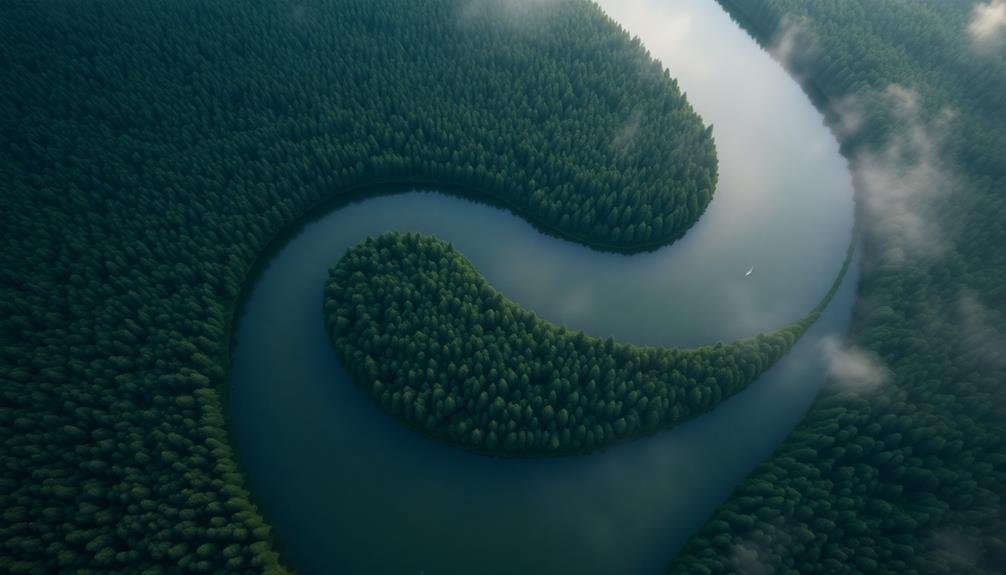
When shooting from above, you'll encounter both symmetry and asymmetry in your compositions.
You can create balanced images by centering natural or man-made patterns, or opt for unbalanced shots that highlight contrasting elements.
Whether you're capturing the geometric precision of city blocks or the organic flow of riverbeds, aerial photography offers unique opportunities to play with visual equilibrium and tension.
Balanced vs. Unbalanced Compositions
Exploring symmetry and asymmetry from above opens up a world of creative possibilities in aerial photography. As you experiment with balanced and unbalanced compositions, you'll discover how negative space can dramatically impact your images.
Balanced compositions often create a sense of harmony and stability, while unbalanced compositions can evoke tension or dynamism.
When crafting balanced compositions, aim to distribute visual elements evenly across the frame. This doesn't mean everything must be perfectly symmetrical; instead, endeavor for a sense of equilibrium.
Unbalanced compositions, on the other hand, intentionally place more visual weight on one side of the frame, creating a sense of movement or directing the viewer's attention.
Consider these techniques when working with balanced and unbalanced compositions:
- Use the rule of thirds to create subtle balance
- Experiment with diagonal lines to add dynamic tension
- Place a single strong element against a large negative space
- Create balance through color or tonal contrast
- Utilize natural patterns and repetition to achieve symmetry
Natural vs. Man-Made Patterns
From high up in the sky, the Earth's surface reveals a fascinating interplay between natural and man-made patterns. As an aerial photographer, you'll find that these contrasting elements create unique opportunities for using negative space effectively.
Natural patterns often showcase organic, flowing shapes. You'll see meandering rivers, winding coastlines, and rolling hills that create irregular negative spaces. These asymmetrical forms can add a sense of movement and unpredictability to your compositions. Look for the negative space between tree canopies in forests or the gaps between sand dunes in deserts.
Man-made patterns, on the other hand, tend to be more geometric and structured. Cities, agricultural fields, and industrial complexes offer straight lines, grids, and symmetrical shapes. These create uniform negative spaces that can convey order and human intervention in the landscape. Pay attention to the spaces between buildings, roads, or crop circles.
To create compelling aerial photographs, try juxtaposing natural and man-made patterns. Capture the contrast between a winding river and adjacent farmland, or show how urban development encroaches on natural areas. By highlighting these differences through negative space, you'll tell powerful visual stories about our relationship with the environment.
Contrasting Elements From Above
Two powerful tools in aerial photography are symmetry and asymmetry, which create striking contrasts when viewed from above. When you're framing your shots, look for patterns that either align perfectly or deliberately break from uniformity.
Symmetrical elements often evoke a sense of order and balance, while asymmetry can introduce tension and visual interest.
To capture compelling contrasts from above, consider these elements:
- Geometric shapes in urban landscapes
- Natural curves juxtaposed with straight lines
- Light and shadow interplay
- Color variations in agricultural fields
- Water bodies intersecting with land
You'll find that man-made structures often provide excellent opportunities for symmetrical compositions, such as perfectly aligned rows of buildings or radial patterns in roundabouts.
On the other hand, nature tends to offer more asymmetrical arrangements, like winding rivers cutting through forests or irregular coastlines.
Don't be afraid to experiment with your framing. Sometimes, slightly off-center compositions can create a more dynamic image than perfect symmetry.
Highlighting Patterns Through Separation
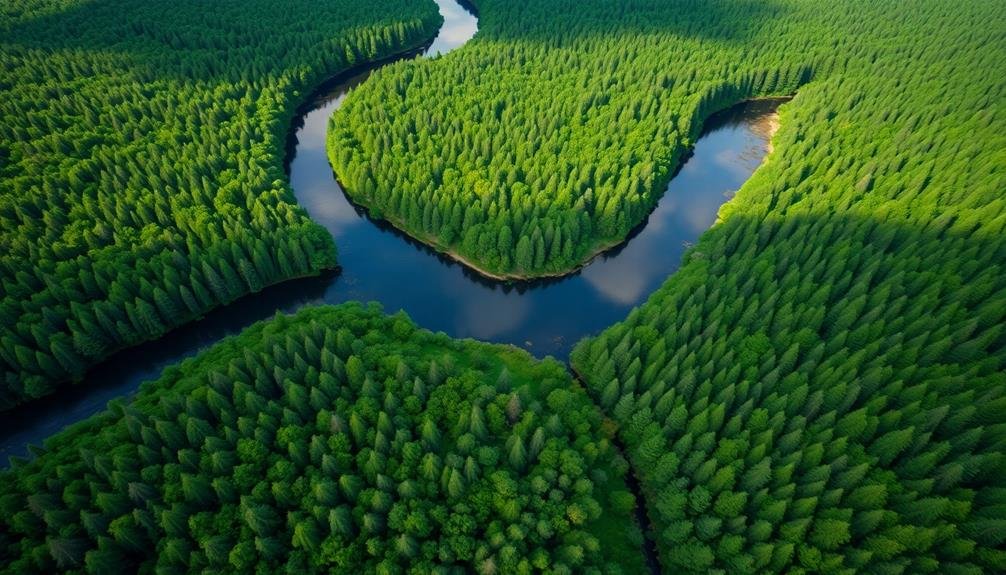
When you're capturing aerial shots, you'll find that negative space can be a powerful tool to highlight patterns.
You can use it to isolate geometric shapes in urban landscapes, drawing attention to the striking lines and angles of buildings and roads.
In natural settings, you'll want to emphasize formations like river deltas, mountain ranges, or desert dunes by allowing empty space to frame and accentuate their unique contours.
Isolate Geometric Shapes
Isolating geometric shapes in aerial photography can create striking compositions that highlight patterns and structures. As you frame your shots, look for distinct shapes that stand out against their surroundings. These can be natural formations or man-made structures that form circles, squares, triangles, or more complex polygons.
To effectively isolate geometric shapes, you'll want to:
- Use a higher altitude to minimize distracting details
- Adjust your angle to emphasize the shape's outline
- Experiment with different times of day for ideal lighting
- Utilize contrast in color or texture to make shapes pop
- Consider post-processing techniques to enhance separation
When you've identified a compelling shape, position it within your frame to maximize its impact. You can place it centrally for a symmetrical composition or off-center using the rule of thirds.
Don't be afraid to crop tightly around the shape, eliminating extraneous elements that might detract from its form. Remember, negative space isn't just empty area; it's an active part of your composition that gives the geometric shape room to breathe and command attention.
Emphasize Natural Formations
Natural formations offer a wealth of opportunities for creating enchanting aerial photographs. When you're capturing landscapes from above, use negative space to emphasize these formations and create visually striking images.
Look for expansive, uniform areas like deserts, oceans, or snowfields that can serve as a blank canvas for your subject. To highlight natural patterns, focus on the contrast between the formation and its surroundings. Rivers winding through arid landscapes, volcanic islands emerging from the sea, or glacial crevasses cutting through ice fields all provide excellent opportunities.
You'll want to position your subject off-center, allowing the negative space to draw the viewer's eye to the formation. Consider the play of light and shadow when composing your shot. Early morning or late afternoon light can create long shadows that accentuate the texture and shape of landforms.
Don't be afraid to zoom in on smaller details, like sand dunes or rock formations, using the surrounding emptiness to isolate and emphasize their unique characteristics. By skillfully employing negative space, you'll create aerial photographs that showcase the beauty and complexity of natural formations in an enthralling way.
Negative Space in Urban Aerials
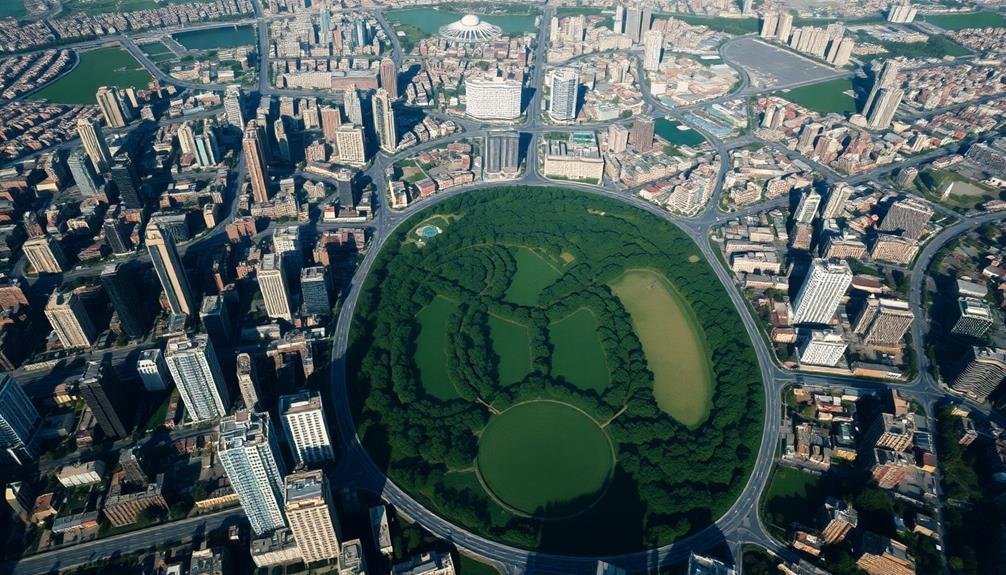
Urban landscapes provide a unique canvas for exploring negative space in aerial photography. When shooting cities from above, you'll find countless opportunities to capture striking compositions that balance structures with empty areas. Look for geometric patterns formed by streets, buildings, and open spaces. These elements can create powerful visual contrasts that draw the viewer's eye.
To effectively use negative space in urban aerials:
- Focus on minimalist compositions, isolating a single building or structure
- Capture wide expanses of parking lots or parks surrounded by dense cityscape
- Highlight the interplay between skyscrapers and the sky
- Frame shots to emphasize the grid-like layout of city blocks
- Use shadows cast by tall buildings to create interesting negative shapes
As you're composing your shots, pay attention to the balance between positive and negative elements. The empty spaces should complement and enhance the urban structures, not overpower them.
Experiment with different altitudes and angles to find the most compelling compositions. Remember, negative space doesn't have to be completely empty; subtle textures or patterns in open areas can add depth to your images while still maintaining a sense of spaciousness.
Frequently Asked Questions
What Camera Settings Are Best for Capturing Negative Space in Aerial Photography?
You'll want to use a wide aperture (low f-number) for a shallow depth of field. Set a fast shutter speed to freeze motion, and keep ISO low for clean images. Experiment with different focal lengths to frame your subject.
How Does Weather Affect the Use of Negative Space in Aerial Shots?
Weather greatly impacts your use of negative space in aerial shots. You'll find clear skies create crisp, defined spaces, while clouds add texture and depth. Fog can obscure details, enhancing negative space's effect. Rain often limits opportunities.
Are There Legal Restrictions on Using Drones for Aerial Negative Space Photography?
You'll face legal restrictions when using drones for aerial photography. Check local laws, obtain necessary permits, and follow regulations on flight altitude, no-fly zones, and privacy concerns. Don't forget to register your drone if required.
Can Negative Space Techniques Be Applied to Nighttime Aerial Photography?
Yes, you can apply negative space techniques to nighttime aerial photography. You'll find that city lights, illuminated structures, and dark areas create striking contrasts. It's challenging but rewarding. You'll need to master long exposures and light sensitivity.
What Post-Processing Techniques Enhance Negative Space in Aerial Images?
You can enhance negative space in aerial images through post-processing by increasing contrast, adjusting exposure, and using selective color. Don't forget to experiment with black and white conversions and vignettes to emphasize your subject's isolation.
In Summary
You've now got a range of techniques to leverage negative space in your aerial photography. By using the sky, vast landscapes, and open areas creatively, you'll add depth and impact to your shots. Don't be afraid to experiment with minimalism, scale, and isolation. Remember, sometimes less is more. As you take to the skies, keep these approaches in mind and you'll capture stunning images that truly stand out.

As educators and advocates for responsible drone use, we’re committed to sharing our knowledge and expertise with aspiring aerial photographers.




Leave a Reply